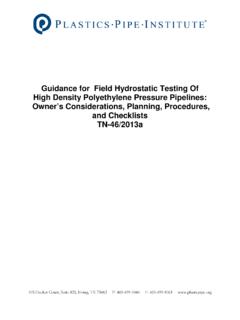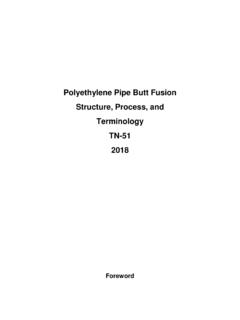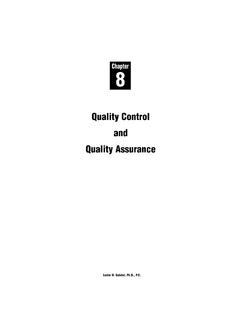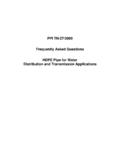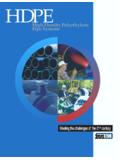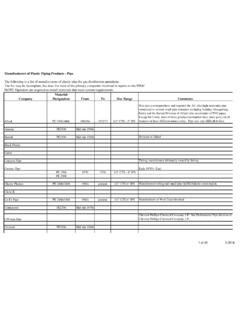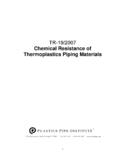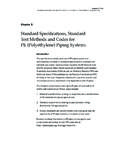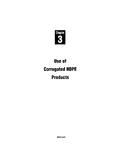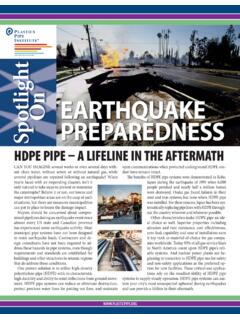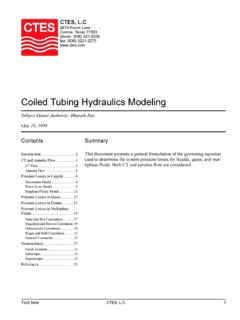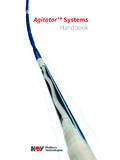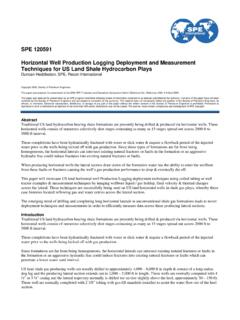Transcription of Chapter 2 - Inspections, Tests and Safety …
1 Chapter 2 Inspections, Tests and Safety Considerations15 Chapter 2 Inspections, Tests and Safety ConsiderationsScopeOnce a PE piping system has been selected and designed for an application, the design is implemented by procuring the pipe, fittings and other necessary appurtenances, installing the system, and placing it in service. Piping installation involves people and machines in motion to move, assemble, install, inspect and test the piping system. Whenever moving machinery, piping parts, and personnel are engaged in piping system construction, Safety must be a primary consideration.
2 This Chapter presents some of the inspections, Tests and Safety considerations related to installing PE piping, placing an installed system in service, and operating a PE piping statements are provided in this Chapter , but this Chapter does not purport to address all of the product applications, inspections, Tests , or construction practices that could be used, nor all of the Safety practices necessary to protect persons and property. It is the responsibility of the users of this Chapter , installers, inspectors and operators of piping systems to establish appropriate Safety and health practices, and to determine the applicability of regulatory limitations before any use, installation, inspection, test or operation.
3 IntroductionGenerally, piping system installation begins with the arrival and temporary storage of pipe, fittings, and other goods required for the system. Assembly and installation follow, then system testing and finally, release for operation. Throughout the installation process, various inspections and Tests are performed to ensure that the installation is in accordance with specification requirements and that the system when completed is capable of functioning according to its design specifications. In the selection, design, and installation of PE piping systems, professional engineering services, and qualified installers should be 151/16/09 9:43:55 AMChapter 2 Inspections, Tests and Safety Considerations16PE piping products are integrated pipe and fitting systems for a broad range of commercial, municipal, utility and industrial applications.
4 They may be buried, laid on the surface, supported above grade, installed underwater, or floated on the surface of lakes or piping products are manufactured from 1/4 (6 mm) diameter through 120 (3050 mm) diameter under applicable industry standards (ASTM, AWWA, etc.) for pressure and non-pressure applications. As well, PE fittings, custom fabrications, special structures and appurtenances are available for full pressure rated, reduced pressure rated, or non-pressure rated extruded PE pipes have homogeneous walls and smooth interior and exterior surfaces.
5 Profile pipes are manufactured by extruding a profile over a mandrel. These pipes have smooth interiors, and may have a smooth or a profiled exterior. Fittings, fabricated structures, tanks, and manholes are constructed for pressure, low pressure and non-pressure applications. Smaller size fittings are usually injection molded. Larger fittings, fabricated structures, tanks, and manholes are fabricated in manufacturer s facilities. Thermal joining techniques used for fabrication usually limit the design pressure capacity of the structure. Complex structures are generally not suitable for field Piping in the Field After the piping system has been designed and specified, the piping system components must be procured.
6 Typically, project management and purchasing personnel work closely together so that the necessary components are available when they are needed for the upcoming construction for Commercial Transport PE fittings, fabrications and pipe are shipped by commercial carriers who are responsible for the products from the time they leave the manufacturing plant until they are accepted by the receiver. Molded fittings and small fabrications and components are usually packaged in cartons. Large orders may be palletized. Large fabrications may require custom packaging.
7 Commercial transport may be by parcel service or commercial carrier in enclosed vans or on flatbed trailers depending on 161/27/09 11:01:32 AMChapter 2 Inspections, Tests and Safety Considerations17 Figure 1 Typical Truckload of coiled , Silo-Pack Pipe (40 Trailer)PE pipe is produced in coils or in straight lengths and shipped on fl atbed trailers. Coils are typically limited to 6-inch and smaller sizes. Coils may be laid fl at and stacked together into silo packs, or may be individual large vertical coils, or may be reels of coiled pipe. Straight lengths are bundled together in bulk packs or loaded on the trailer in strip loads.
8 Standard straight lengths for extruded pipe are 40 feet long; however, shorter lengths or lengths 60 feet long or longer depending on transportation restrictions may be produced. State transportation restrictions on length, height and width usually govern allowable load confi gurations. Higher freight costs may apply to loads that exceed length, height, or width restrictions. Although PE pipe is lightweight, weight limitations may restrict load size for very heavy wall or longer length pipe. Profi le wall extruded pipes 96-inch ID (2438 mm ID) and 120-inch ID (3048 mm ID) will exceed 8 feet overall permissible width, and are subject to wide load 1 through 3 are general illustrations of truckload and packaging confi gurations for conventionally extruded PE pipes.
9 Actual truckloads and packaging may vary from the illustrations. Nesting , or sliding a smaller pipe length inside a larger pipe, is generally not practiced for commercial fl atbed loads because it is diffi cult to remove the inner pipe when the load is delivered at the jobsite, because nesting can result in an overweight load, and because most commercial fl atbed trailers do not have structural bulkheads at both ends to prevent nested pipes from sliding out during acceleration or braking. Fully enclosed containers for overseas delivery can occasionally be nested.
10 Occasionally, silos of small tubing sizes may be nested in silos of larger coiled pipe. Nested silos must have special packaging to lift the tubing silo out of the pipe silo. De-nesting should only be performed after the nested silos have been unloaded from the truck and placed on the ground. ! 171/16/09 9:43:56 AMChapter 2 Inspections, Tests and Safety Considerations18 Figure 2 Typical Straight Length Bulk Pack Truckload !!Figure 3 Typical Straight Length Strip Load Truckload Occasionally, when coiled pipe silo packs and boxed fi ttings are shipped together, fi tting cartons are placed in the center of the silo packs.
